

Lowering operational carbon and reducing energy costs are high on the agenda for many organisations who are looking ahead to secure dependable energy sources in the most sustainable way for the business and the planet.
Recent technological advances in the solar PV industry have made retrofitting solar PV systems onto existing commercial buildings more financially and environmentally advantageous than ever before. As a result, solar PV systems are often considered the desired renewable energy source across the education, healthcare, manufacturing, and private sectors.
In this article, we will explore the benefits of solar installations for retrofitting and the essential design requirements to consider in a project.
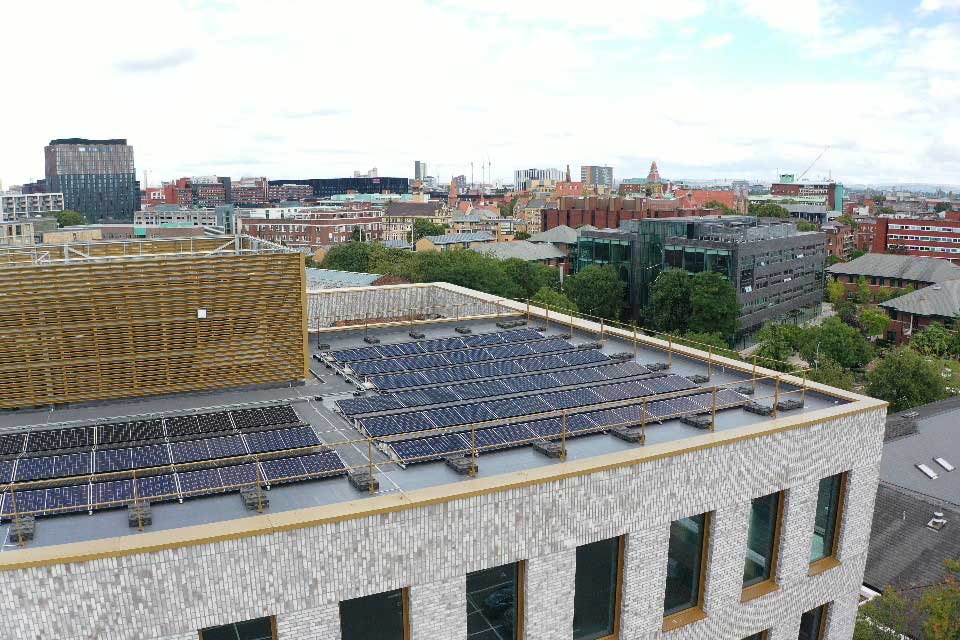
Public Sector Decarbonisation Scheme
On 19th June 2019, the UK set a landmark precedent by becoming the first major economy to legally commit to achieving net zero greenhouse gas emissions by 2050.
Following the announcement of the next phase of the Public Sector Decarbonisation Scheme in February 2024, the Department for Energy Security and Net Zero has earmarked £1.17 billion in funding for public sector energy improvements, facilitated through Salix Finance. This initiative includes significant support for installing commercial solar PV systems to enhance building energy efficiency.
For commercial landlords and facilities managers, integrating solar PV technology into your properties offers a strategic advantage. Adopting solar energy can accelerate your journey toward Net-Zero targets, ensure compliance with the Minimum Energy Efficiency Standards (MEES), and enhance your property’s Energy Performance Certificate (EPC) rating. Meeting these standards is crucial, with a minimum EPC C rating required by 2027 and EPC B by 2030.
Investing in solar PV as a retrofit solution aligns your properties with future regulatory requirements and delivers tangible benefits, such as reduced operational costs and increased property value. This will position your buildings at the forefront of sustainability and energy efficiency, attracting environmentally conscious tenants and securing long-term returns.
Rising Energy Costs
Approximately 14% of the UK’s net greenhouse gas emissions come from electricity supplied to homes and businesses. Despite 40% of grid electricity being sourced from renewables, it is still mixed with gas-generated electricity, meaning energy rates remain vulnerable to fluctuations in gas prices. The demand for gas surged as the UK emerged from the pandemic in 2021, exacerbated by supply shortages and further escalated by Russia’s invasion of Ukraine, leading to even higher electricity prices.
While the government has introduced an Energy Price Guarantee to cap energy prices for the domestic market, no such protections exist for businesses and non-domestic energy tariffs, exposing commercial energy users to future price hikes.
This presents a compelling case for commercial landlords and facilities managers to invest in solar PV installations. Recently, Garland UK worked closely with a Multi-Academy Trust, delivering a solar and metal roof scheme which achieved over £5,000 in energy savings in the 1st year of installation alone.
By generating your own renewable energy on-site, you can significantly reduce your dependence on the grid, insulating your properties from unpredictable energy costs and enhancing energy security. Additionally, this move supports your sustainability goals, reduces your carbon footprint, and demonstrates a commitment to environmental responsibility.
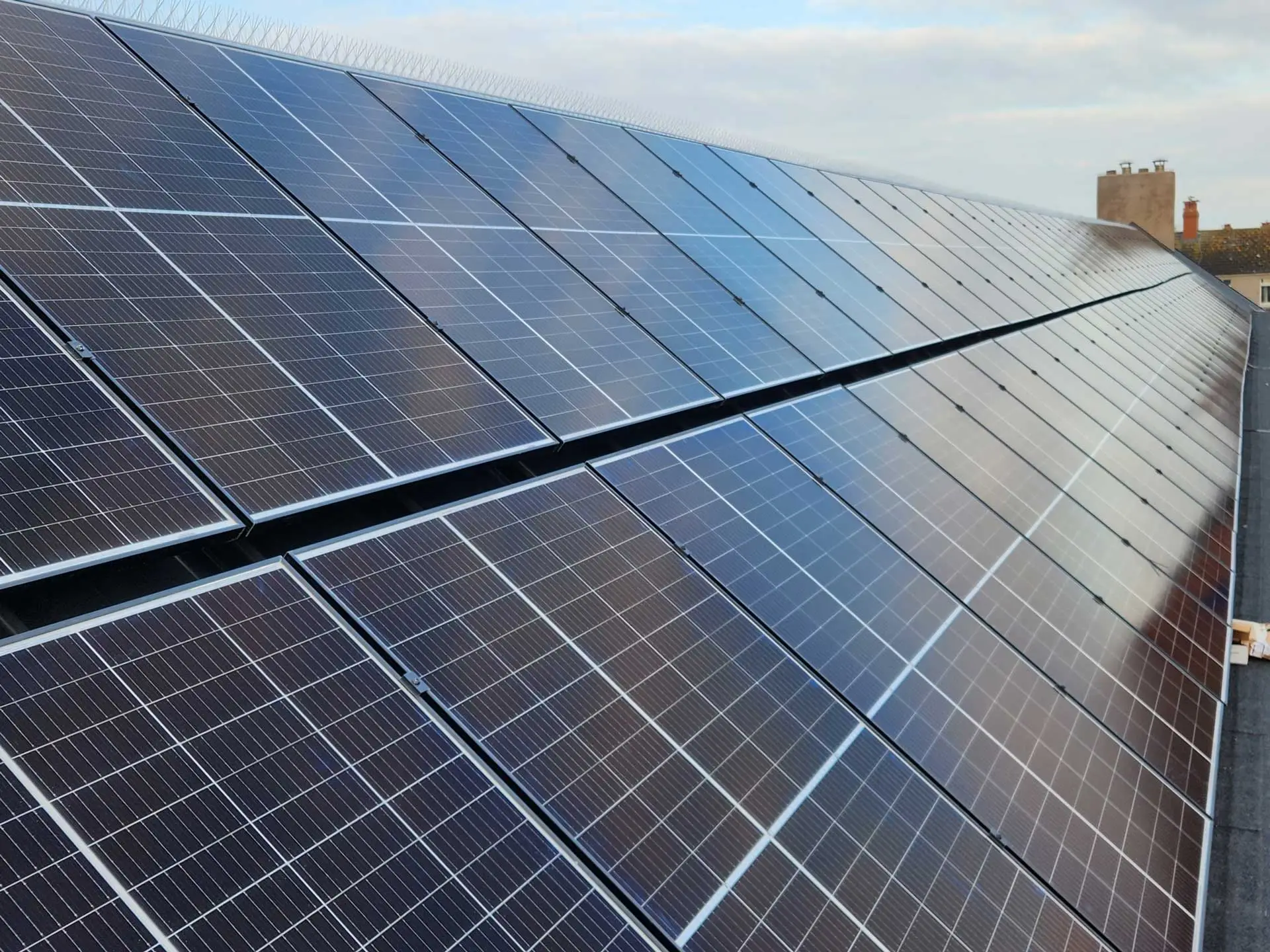
Design Considerations
Feasibility
The first specification stage assesses the building’s eligibility for a roof-top solar PV installation. Though solar PV is considered to meet the requirements for Permitted Development under Class J of the Town and Country Development Order 2015, to qualify, certain conditions must be met:
- Roof-mounted or wall-mounted commercial solar panels should project no more than 200mm from the wall surface or roof slope
- With pitched roof and flat roof installations, the panels need to be situated at least 0.4m from the external edges of the roof or the wall joint that they sit on
- With flat roof installations only, the roof-mounted panels should protrude less than 1m from the roof surface, and they cannot be the highest part of the roof (excluding the chimney)
It is important to mention that the building owner must seek planning permission if any of the following conditions apply:
- Solar PV installation on a listed building or any building within the curtilage of a listed building (i.e. within its grounds)
- The proposed installation site is a designated ancient monument
- Your installation site is within any other type of conservation area that’s subject to specific local rules (for example, an Area of Outstanding Natural Beauty)
- If the building is on Article 2(3) designated land, and the equipment is not installed on a wall or a roof slope which fronts a highway
Should your building meet the eligibility requirements, the next step is to assess the structural suitability for a PV array installation. Garland UK strongly recommends consulting a structural engineer to evaluate the maximum load capacity the building’s roof can support. This step is especially crucial for low-pitched or flat roof installations, ensuring the system’s weight is within safe limits.
Several flat roof PV mounting solutions can help reduce the weight of the ballasting system if necessary. Options include mechanically fixing the mounting structure to the roof deck or using retrofitted torch-on systems that require no ballast and minimal penetrative fixings. The latter option has the added advantage of preserving the waterproofing integrity of the roof substrate.
A PV system can be tailored to weigh between 8 and 25 kg/m², depending on specific requirements. Factors such as building location and height are also considered at this stage to account for wind uplift calculations.
For commercial landlords, this detailed planning ensures the safe and effective installation of a solar PV system. It optimises energy generation while maintaining the structural integrity and waterproofing of your building. By addressing these factors, you can confidently move forward with a sustainable energy solution that enhances property value and aligns with environmental goals.
Existing Roof Condition
With PV modules now offering up to 30 years of performance guarantee and 30 year product guarantees, conducting a technical survey and assessing the roof on which the system is installed is always good practice.
A full envelope where the roof and PV system carry the same guarantee lengths provides the most efficient outcome for future savings, considering the cost of removing PV systems from a substandard roof structure can be quite costly and affect the length for ROI on the PV system through energy savings.
Design
The design of a PV system is based on a building’s energy needs and will be tailored to meet the site’s energy and sustainability goals. The PV system is designed to cope with a building’s peak demand (the maximum energy required at any point) by analysing energy consumption data.
With return on investment in mind, your solar PV system should avoid any excess energy produced from being exported back to the grid. Currently, the financial benefits of export are very minimal, and with the rapid increase in solar installations across the UK, Distribution Network Operators (DNOs) may apply export limitations on application due to the increased supply infrastructure. It is worth bearing in mind that all systems over 11.04kWp (3-Phase) require submission of a DNO G99 or “apply to connect” application.
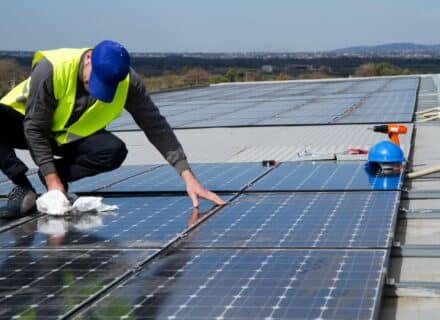
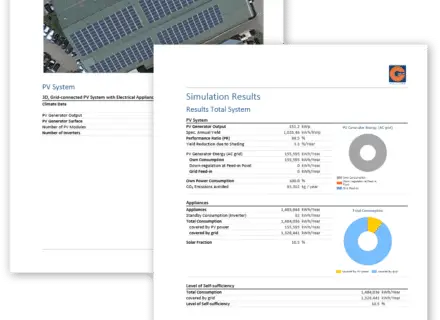
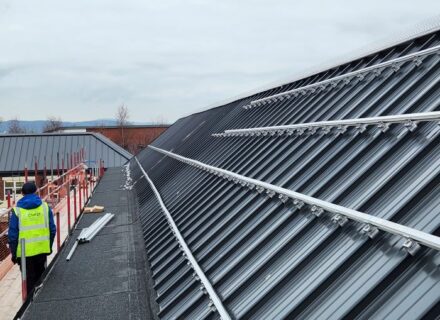
Solar Yield Analysis
Upon design, a yield analysis can be produced. This analysis is calculated using industry-specialised software, enabling the client to see potential yearly carbon emissions reductions.
For example, the outputs of a typical Garland UK Solar Yield Analysis include a comprehensive report summarising the findings from the power production,
cash-flow projection, initial budget, and environmental analysis. A proposed system design will be shared that has been tailored to the building’s specific requirements, and finally, an initial budget outlining the potential roof refurbishment costs (if relevant) and a breakdown of expected savings and payback period.
Garland UK can calculate ROI through savings on energy previously obtained through the network grid. With the current economic climate, an ROI of between 4-6 years is achievable with an IRR of 20-25%.
Below is an example 4,000 m2 food production factory project where our client utilised our Solar Yield Analysis to understand the annual energy cost savings that could be achieved if a solar PV system were installed. The simulation included a 165kWp PV array with an initial £ investment value of £ 165,000.
The PV system would achieve a 4 year ROI, based on an average UK annual inflation rate of 9% and generate £2.9M in energy savings by the 25th year.
| ROI | ||||
| Year | Annual Electricity costs without PV | Annual Electricity costs with PV | Savings | -£165,000.00 |
| 1 | £184,383.79 | £149,902.28 | £34,481.51 | -£130,518.49 |
| 2 | £200,978.33 | £163,393.49 | £37,584.85 | -£92,933.64 |
| 3 | £219,066.38 | £178,098.90 | £40,967.48 | -£51,966.16 |
| 4 | £238,782.36 | £194,127.80 | £44,654.56 | -£7,311.60 |
| 5 | £260,272.84 | £211,599.36 | £48,673.48 | £41,361.88 |
| Total Accrued 25th Year | £15,617,472.21 | £12,696,857.37 | £2,920,614.84 | £2,755,614.84 |
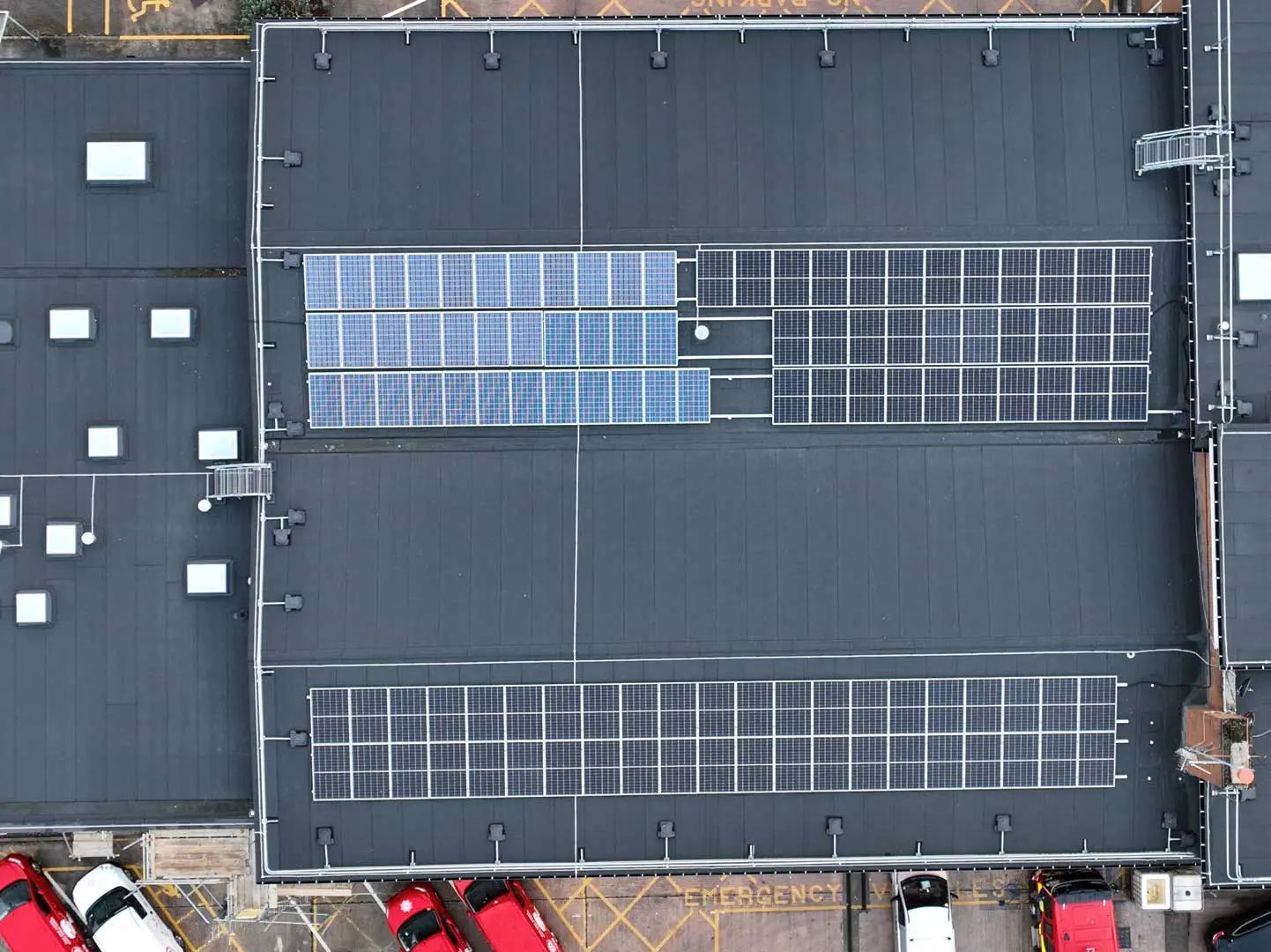
Fire Safety
Increased attention over the fire safety of Solar PV systems has been a topic of debate, heightened with a recent solar panel fire at a 45,000m2 commercial warehouse. It is believed the fire was caused by an electrical fault, which caused the solar panels to catch fire.
With this in mind, there are several system specifications which can be introduced to alleviate the risk of fire within the design stage:
- Design the PV array to allow for continuous airflow
- Specify fire class ‘A’ rated glass/glass modules which encapsulate combustible components
- Installation of ‘Fireman switch’ and accessible isolation
- Correct maintenance and inspection intervals
- Conformance-compliant enclosures on each electrical connection
- Panel array separation to avoid fire spread.
- Installation procedure carried out by competent and qualified personnel
Future-proofing Considerations
We have discussed the importance of investigating a building’s structural integrity to support solar PV panels. One step further is to consider the requirement for more energy storage units in the future.
Imagine scalable, adaptable energy systems that meet growing energy demands; for example, there is an ever-increasing need for charging for electric vehicles (EVs). In addition, with the global directive to eliminate the use of fossil fuels, we could expect to see increased demand for innovative electrical heat supply solutions.
Integrating battery storage solutions can further utilise PV-generated energy for direct consumption. When coupled with a dedicated generator, backup power can be provided, particularly when adopting smart grid technology for dynamic energy distribution, which can offer greater resilience against any potential grid outages.
Looking ahead, with the use of export limitation devices, it is possible to plan for potential expansions by designing modular solar PV systems that can be easily upgraded, which will help save costs in the long term. Where possible, it is important to engage with stakeholders to understand their long-term energy needs and sustainability goals, ensuring the solar PV installation aligns with future business growth and environmental targets. This holistic approach ensures that commercial buildings remain efficient, sustainable, and adaptable to future energy requirements.
Embrace the future of Solar PV
Retrofitting with solar PV offers commercial building owners a strategic advantage in today’s energy landscape. With rising energy costs and increasing regulatory pressure to meet Net-Zero targets, investing in solar is not just a sustainable choice but a smart financial decision.
By generating your own renewable energy, you can significantly reduce dependence on the grid, protect your business from future energy price hikes, and ensure compliance with the Minimum Energy Efficiency Standards (MEES). This proactive approach not only improves your building’s Energy Performance Certificate (EPC) rating but also positions your property as a leader in sustainability, attracting environmentally conscious tenants and investors.
Careful planning and consideration of structural suitability ensure that your PV system will be safe, effective, and tailored to your specific needs. From preserving the waterproofing integrity of your roof to optimising energy generation, solar PV offers many benefits.
Utilising the untapped potential of an empty rooftop can benefit two-fold: Secure investment on a property with market immunity and accelerated progress in the challenge to meet environmental target requirements
Justyn Irons, Technical Manager, Garland UK
